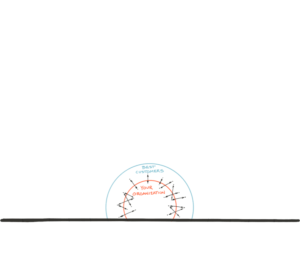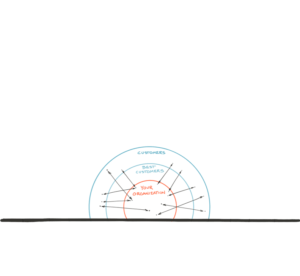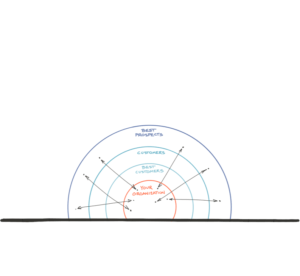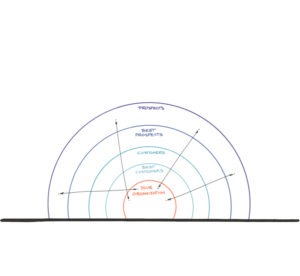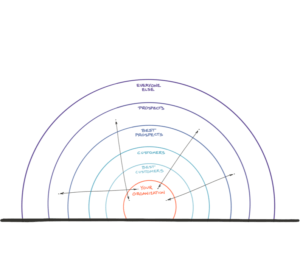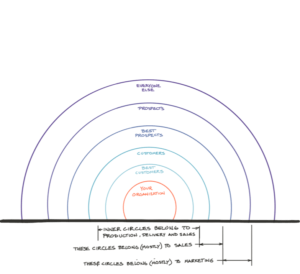Still thinking about a marketing resolution for 2018? I recommend this one.
By David Chapin
SUMMARY
VOLUME 10
, NUMER 1
As we begin 2018, there’s one marketing resolution I wish you’d make. Make this marketing resolution, then actually implement it, and you’ll change the trajectory of your marketing efforts—you’ll gain clarity and make a positive difference on all your marketing activities throughout the year. This marketing resolution has three parts. But to understand it, you […]
As we begin 2018, there’s one marketing resolution I wish you’d make. Make this marketing resolution, then actually implement it, and you’ll change the trajectory of your marketing efforts—you’ll gain clarity and make a positive difference on all your marketing activities throughout the year.
This marketing resolution has three parts. But to understand it, you need some context.
Imagine a set of concentric circles.
Inside this set of concentric circles, right at the center, is the smallest circle. This represents your organization. All your employees are inside, as are your SOPs, your IP and your culture. Communication inside this circle is rich and dynamic, isn’t it? You’ve got your intranet, SharePoint and Slack (or whatever tools you use to share files and messages) and more. Communication is rapid, spontaneous and high-octane.
Right outside of that circle is another one. Rather than employees, it’s full of your very best customers and suppliers. Communication between the two circles is typically not as dynamic. After all, most firms won’t give customers access to their intranet, or their instant messaging platform. But still, there’s lots of exchange between these two circles. Your client-facing employees know these customers really well.
And outside of that circle is another. This has the majority of your customers in it. Communication between your organization and this circle is less dynamic or robust than it is between the inner two circles. At this level, there may be a few phone numbers saved in speed dial, but relationships—and communications—are more impersonal.
And outside of that circle is another. This one has “good” prospects in it. These folks haven’t yet “crossed the line” to buy from you. But they’re interested. They’ve subscribed to your content. They watch your webinars and read your white papers. They’re talking with sales people. Communication here is more limited than with customers.
And outside of that circle is another, with the rest of your prospects in it. These people have heard of your firm. They may not know much about you, but they have a need. They’ll be buying from someone; maybe not from you, maybe not today, but from someone, someday. Direct communication with these folks is sparse; they may not have raised their hand to start chatting with sales people. They’re busy and they don’t want to be bothered. They don’t have any loyalty to you. Whatever information they’ve learned about your firm comes from many different sources, but typically not from you. In fact, some of what they “know” about you might not be true. But they believe it nonetheless.
And outside of that circle is one more. This one has in it all the people who have never heard of your firm. They know nothing about you. In essence, this circle contains everyone else in the world.
We’ll get to the marketing resolution. First, some useful questions.
There are many differences between the people in these different circles, including what they know about your firm and how rich the communication is between you and them.
The differences between these circles will give rise to the marketing resolution, but first, I’ve want to ask you some questions.
How do you grow your firm? That is: how do you make the circle that represents your firm bigger? You grow your firm by getting more customers, by making the “best customers” and “customers” circles bigger. And to do that, you need the “prospects” circle to be bigger. To grow your firm, you need to increase all these circles—“best customers,” “customers” and “prospects.”
Which circle has the most people in it? Unless you work for one of the global mega-brands, like Coke or IBM, the outermost circle has the most people in it. For most of you reading this, there are many, many more people in the world who have never heard of your firm than there are people in all the other circles combined. This is actually a huge opportunity; you’ve got room to grow.
How do you grow these circles? To get these circles bigger, you need to get people to step inwards, toward you. You want people who are in the “never heard of your firm” to step closer, into the “prospects” circle. And you want people who are in the “prospects” circle to step closer, into the “best prospects” circle. And so on and so on, until people step into the “best customers” circle. You want people to step closer, from whatever circle they’re in into the next one.
And this is one way to think about your organization’s offering: you must create and communicate clear, compelling value so that people are encouraged to take a step towards you (or at least not be given any reason to take a step away). While this model is simple, the significant truths it contains should guide your behavior.
Who owns each of these circles? Your production and delivery teams “own” the inner circles; they’re responsible for keeping customers happy. Your sales function owns the middle circles; they’re responsible for helping people in the “prospects” circles step into the “customers” circle, and from there into the “best customers” circle. And the marketing function owns the outer circles; they’re responsible for helping people learn about you, learn about what you stand for, and understand the value you offer. There’s some overlap, of course; many people inside your organization will touch your customers, and both your sales and marketing functions will touch your prospects.
The further out you go, the harder it is to communicate clearly.
In the innermost circles, communication between your firm and your best clients is robust and multi-channel. This communication has lots of nuance, and it originates from many sources within your organization.
As you travel farther out, what happens? Communication thins out. Looking at the communication between your firm and these outer circles, there’s less of it, and it happens through fewer channels. This communication is more subject to misinterpretation than that with people in the inner circles. Their attention span is shorter; they’re more distracted.And as you move outward, the environment gets noisier. Audiences are being bombarded with more messages of all different kinds.
We’re almost to the marketing resolution. Just one more question.
Given this noisy environment, full of people who may or may not care a lot about what you’re saying, how can you be most effective with your marketing communications? How can you get them to take a step closer to you?
The answer has three parts. I’ll take these in reverse order, starting with the easiest first.
Third, you must express yourself consistently.
Repetition is the key to getting your message through, because your prospects aren’t listening carefully, and they’re likely to misinterpret what you’re saying. This is so important that I’ll say it again.
Repetition is the key to getting your message through. Repetition gives the right message a chance to cut through the noise. This is so important that I’ll say it again.
Repetition is the key to getting your message through.
You must be consistent. While expressing yourself consistently is the easiest of the three parts to accomplish, it actually requires significant discipline to be consistent, and many life science organizations don’t do a great job at this. Rather, they go wandering around, shouting about whatever message the VP thinks is important this week. Consistency, consistency, consistency. Repetition, repetition, repetition. That’s how you can drive your message home.
Second, you must articulate clearly.
You must articulate your message in language and visuals that your prospects will understand. This requires clarity. Achieving this clarity can require some experimentation, and can be greatly enhanced with market research.
Consistency and clarity will give your message a chance to be heard. But I’ve saved the most challenging, and primary, part for last: what message should you be communicating clearly and consistently?
First, and most important, you must choose a clear position.
Your message must communicate your position, the “one thing” you want to be known for.
For example, when I say “Volvo,” what comes to your mind? For most people it’s the idea of “safety.” When I say “Walmart,” most people think of “low prices.” Volvo’s position is related to safety; Walmart’s is related to low prices. These companies don’t waver. They focus on clearly articulating the “one thing” they want to be known for, and then they express it over and over and over, clearly (the second step) and consistently (the third step).
The most important action you can take as a marketer is to decide on the “one thing” that your organization stands for—that’s step one. Then, you need to articulate this “one thing” clearly (step two), and then express this “one thing” consistently (step three). You embed this “one thing” in the minds of your audiences through clarity and repetition.
This “one thing” is your position. David Ogilvy (of advertising fame) loosely defines a position as: what a product/service does, and who it is for. I don’t think that goes far enough. Your position must also clarify what makes your offering unique. In fact, your position must meet seven clear criteria. Your position must be:
Clear (Is it easy to explain to a co-worker: “Oh, we’re the _____ ones”?)
Unique (Does it separate you from your competitors?)
Authentic (Does it fit who you are and want to become? Does it ring true?)
Sustainable (Is it ownable? Can you maintain this for 10 years?)
Important to the Audience (Which audience shall we target? Do they care about this?)
Believable to the Audience (Is this credible—or will they scoff, “Yeah, right!”?)
Compelling to the Audience (Will this motivate them to take a step closer?)
Making this positioning decision requires courage. You can’t be all things to all people. You have to have a unique offering. If you make this positioning choice correctly, you’ll draw people to you; they’ll take a step closer.
In sum: your marketing resolution.
If you’re going to make any resolutions about your marketing at the start of this new year, here is one (in three parts) that can give you the most leverage.
Part one. Figure out what your “one thing” is. (And by the way, Make sure it’s clear, unique, authentic, sustainable, important, believable and compelling.)
Then (part two) articulate it clearly, and (part three) express it consistently.
And even if you’re not the resolution type, the start of 2018 is a perfect time to ask: What’s the one thing that you want your prospects to know about you? Is it truly unique? Have you expressed it clearly?
What’s your one thing?
The Marketing of Science is published by Forma Life Science Marketing approximately ten times per year. To subscribe to this free publication, email us at info@formalifesciencemarketing.com.
David Chapin is author of the book “The Marketing of Science: Making the Complex Compelling,” available now from Rockbench Press and on Amazon. He was named Best Consultant in the inaugural 2013 BDO Triangle Life Science Awards. David serves on the board of NCBio.
David has a Bachelor’s degree in Physics from Swarthmore College and a Master’s degree in Design from NC State University. He is the named inventor on more than forty patents in the US and abroad. His work has been recognized by AIGA, and featured in publications such as the Harvard Business Review, ID magazine, Print magazine, Design News magazine and Medical Marketing and Media. David has authored articles published by Life Science Leader, Impact, and PharmaExec magazines and MedAd News. He has taught at the Kenan-Flagler Business School at UNC-Chapel Hill and at the College of Design at NC State University. He has lectured and presented to numerous groups about various topics in marketing.
Forma Life Science Marketing is a leading marketing firm for life science, companies. Forma works with life science organizations to increase marketing effectiveness and drive revenue, differentiate organizations, focus their messages and align their employee teams. Forma distills and communicates complex messages into compelling communications; we make the complex compelling.
© 2024 Forma Life Science Marketing, Inc. All rights reserved. No part of this document may be reproduced or transmitted without obtaining written permission from Forma Life Science Marketing.

